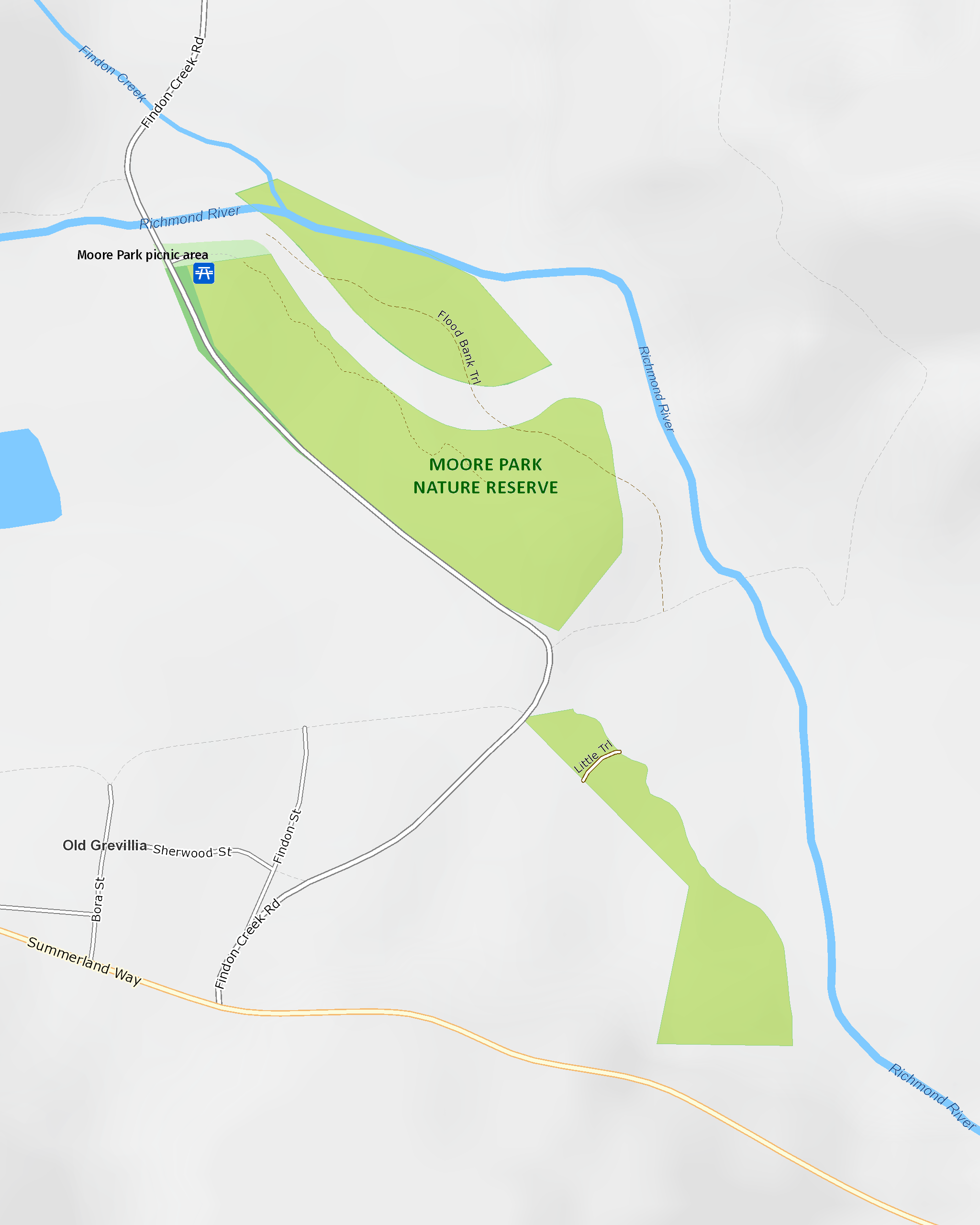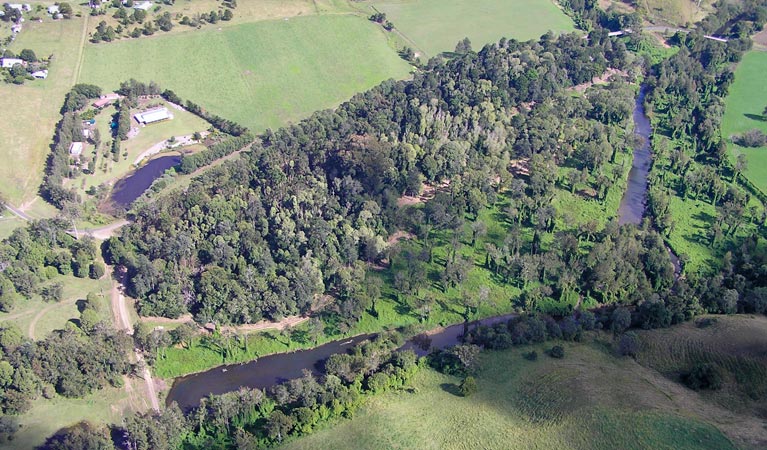Moore Park Nature Reserve
Open, check current alerts
Overview
With its stand of black bean rainforest, Moore Park Nature Reserve offers a rare glimpse of nature alongside the opportunity to picnic and enjoy birdwatching.
Read more about Moore Park Nature Reserve
Walking into the depths of the subtropical rainforest at Moore Park Nature Reserve gives you an idea of what much of the Northern Rivers region must have been like when it was home to the Githabul people. Now, this is one of the largest remaining stands of black bean and silky oak in the entire area.
From October to May, look up into the dense canopy, because this is the maternity ward for thousands of flying foxes. During the summer, you can even see the mothers with their offspring clinging tightly to them. Be quiet though, because they shouldn’t be disturbed. Birdwatchers might also spot rainforest pigeons, including the brilliantly plumaged rose-crowned fruit doves, as well as black bitterns and bush hens.
The picnic area, beside Richmond River, is a cool and peaceful place for a lunch or a barbecue.
Local alerts
For the latest updates on fires, closures and other alerts in this area, see https://www.nationalparks.nsw.gov.au/visit-a-park/parks/moore-park-nature-reserve/local-alerts
Contact
- in the North Coast region
Moore Park Nature Reserve is always open but may have to close at times due to poor weather, flooding or fire danger.
-
-
Kyogle office
02 6632 0000
Contact hours: Monday to Friday, 8.30am to 4.30pm. - 136 Summerland Way, Kyogle NSW 2474
-
Email: npws.richmondriver@environment.nsw.gov.au
-
Kyogle office
Visitor info
All the practical information you need to know about Moore Park Nature Reserve.
Map

Map legend

Getting there and parking
From Kyogle:
- Travel north, about 14km, along Summerland Way through Wiangaree
- Continue north on the Summerland Way another 12km to the intersection with Findon Creek Road at Old Grevillea
- Travel north along Findon Creek Road about 1km to the picnic area. There is a carpark immediately before the bridge over Richmond River
Parking
- Moore Park picnic area See on map
By bike
Check out the Bicycle information for NSW website for more information.
By public transport
Public transport is not available.
Best times to visit
There are lots of great things waiting for you at Moore Park Nature Reserve. Here are some of the highlights.
Autumn
The ripening figs attract numbers of rainforest pigeons.
Spring
The silky oaks are in bloom, their gold flowers brightening the forest.
Summer
More than 10,000 flying foxes use the reserve as a maternity ward. Please ensure you do not disturb them.
Winter
Frosts and fogs hug the forest in the early morning, but once they lift the days are glorious.
Weather, temperature and rainfall
Summer temperature
Average
16°C and 29°C
Highest recorded
42.9°C
Winter temperature
Average
4°C and 20°C
Lowest recorded
-1.4°C
Rainfall
Wettest month
February
Driest month
August
The area’s highest recorded rainfall in one day
210mm
Facilities
Maps and downloads
Prohibited
Pets
Pets and domestic animals (other than certified assistance animals) are not permitted. Find out which regional parks allow dog walking and see the pets in parks policy for more information.
Smoking
NSW national parks are no smoking areas.
Nearby towns
Kyogle (28 km)
Kyogle is an attractive timber-milling town surrounded by rainforest. It's set on the Richmond River at the base of Fairy Mountain.
Casino (59 km)
Casino is a thriving rural centre in the heart of rich agricultural country. It's set in lush pastures on the banks of the Richmond River.
Murwillumbah (94 km)
Murwillumbah is rich dairy, sugar cane and banana country. It's located on the banks of the Tweed River and set in the Tweed River Valley against a backdrop of rainforest-clad hills.
Learn more
Moore Park Nature Reserve is a special place. Here are just some of the reasons why:
Meeting spot

Even before this park was created in 1989, it was an important place for the local community, who have enjoyed its serenity and scenery for decades. Many families would gather here and hold functions in what is now the picnic area beside the Richmond River. The area remains a popular destination for picnics and bird watching.
- Moore Park picnic area Moore Park picnic area offers basic facilities for a leisurely lunch, with terrific opportunities for birdwatching and viewing the large flying fox population.
Fragile forest

Much of the landscape around here would have resembled that of Moore Park Nature Reserve before extensive logging and clearing took place during the 20th century. Now, this 14-hectare reserve represents one of the last remnants of the once much-larger Boyd's Scrub, the most important example of black bean rainforest in the state. Robert J Moore, who was the Kyogle Shire Council president from 1920 to 1936, played a leading role in the council's purchase of what remained of Boyd's Scrub and the reserve is now named in his honour.
- Moore Park picnic area Moore Park picnic area offers basic facilities for a leisurely lunch, with terrific opportunities for birdwatching and viewing the large flying fox population.
First inhabitants

This region of northern NSW is the home of the Githabul Aboriginal people, for whom the rainforest was an extremely important source of food. There are several known sacred sites in the Northern Rivers area.
Flying high

Moore Park Nature Reserve is also a well-known birdwatching area, with species including the tiny varied sittella (also called nuthatches), rose-crowned fruit dove, the barred cuckoo-shrike and the ground-dwelling bush hen. The reserve is also an essential habitat for winged mammals, with both grey-headed flying foxes and endangered black flying foxes raising their young in a canopy nursery from October to May.
- Moore Park picnic area Moore Park picnic area offers basic facilities for a leisurely lunch, with terrific opportunities for birdwatching and viewing the large flying fox population.
What we're doing
Moore Park Nature Reserve has management strategies in place to protect and conserve the values of this park. View the detailed park and fire management documents.

